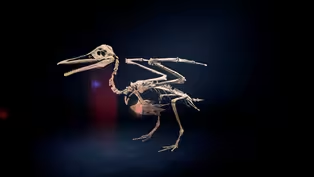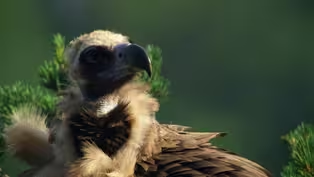
How Birds Survived the Dinosaur Apocalypse
Clip: Season 52 Episode 3 | 2m 48sVideo has Closed Captions
Birds are today’s only living dinosaurs, but how did they survive the asteroid?
Birds are the only dinosaurs still alive today, but how did they survive the asteroid? Most birds were wiped out, along with the rest of the dinosaurs and 75 percent of all life on Earth, but one group of birds made it through. Discover how they endured, and which traits made them resilient in the brutal aftermath of the mass extinction event.
Problems playing video? | Closed Captioning Feedback
Problems playing video? | Closed Captioning Feedback
National Corporate funding for NOVA is provided by Carlisle Companies and Viking Cruises. Major funding for NOVA is provided by the NOVA Science Trust, the Corporation for Public Broadcasting, and PBS viewers.

How Birds Survived the Dinosaur Apocalypse
Clip: Season 52 Episode 3 | 2m 48sVideo has Closed Captions
Birds are the only dinosaurs still alive today, but how did they survive the asteroid? Most birds were wiped out, along with the rest of the dinosaurs and 75 percent of all life on Earth, but one group of birds made it through. Discover how they endured, and which traits made them resilient in the brutal aftermath of the mass extinction event.
Problems playing video? | Closed Captioning Feedback
How to Watch NOVA
NOVA is available to stream on pbs.org and the free PBS App, available on iPhone, Apple TV, Android TV, Android smartphones, Amazon Fire TV, Amazon Fire Tablet, Roku, Samsung Smart TV, and Vizio.
Buy Now

NOVA Labs
NOVA Labs is a free digital platform that engages teens and lifelong learners in games and interactives that foster authentic scientific exploration. Participants take part in real-world investigations by visualizing, analyzing, and playing with the same data that scientists use.Providing Support for PBS.org
Learn Moreabout PBS online sponsorship(asteroid soaring) - [Host] A gigantic asteroid, six miles in diameter collided violently with earth.
(asteroid exploding) Forests burned in volcanic ash, soon filled the skies blocking out the sun.
This was an extreme survival situation, one that 75% of earth's species weren't ready for.
Among the mammals the smallest, some weighing less than one pound managed to escape the catastrophe, as well as some reptiles like turtles and crocodiles.
Birds were also hit hard.
Only the smallest, such as Asteriornis survived the chaos.
How is it that all but one group of birds were wiped out?
What did they have that no other archaic bird and no other dinosaur had?
(steps plodding) Janavis is a bird that did not make it.
Its fossil dates back 67 million years to a time just before the asteroid hit.
Close analysis is helping us to better understand the reasons for its disappearance.
- Here you can see the skeleton of Janavis.
We have some of the bones, particularly the arm bones, and part of the peripheral column.
- [Host] Equipped with teeth Janavis has an imposing stature.
Is this why it didn't survive the asteroid strike?
The key difference between Janavis and Asteriornis is size.
Asteriornis is much smaller, a trait that was key to its survival post-asteroid strike.
- So larger bodied animals through this mass extinction event didn't do very well at all.
So a really big bird like Janavis probably would've been at a major disadvantage compared to Asteriornis after the extinction event.
Getting a meal for an animal the size of Janavis probably would not have been a very easy thing to do.
- They also had very different ecologies.
Janavis was basically a seabird like we will have been fishing and eating fish and squid.
Asteriornis was more like a generalist, ground dwelling, bird eating whatever he found in the beach.
- [Host] With the trees gone, a large number of tree dwelling birds could not survive.
Instead, it was ground dwellers like Asteriornis that held the advantage.
Archaic birds, although more numerous, were devastated by the asteroid.
Their ecosystems were destroyed.
In this hostile environment, their imposing size life in the trees and specialized diets led to their extinction.
Only modern ground nesting birds with more flexible diets were resilient enough to survive a decimated landscape.
(soft music)
Video has Closed Captions
Preview: S52 Ep3 | 29s | Fossils reveal how birds survived the killer asteroid and became today’s only living dinosaurs. (29s)
How Birds Evolved to Fly (feat. Slow-Mo Baby Birds)
Video has Closed Captions
Clip: S52 Ep3 | 2m 56s | Slow-motion footage of baby birds helps scientists uncover how their ancestors took to the skies. (2m 56s)
Providing Support for PBS.org
Learn Moreabout PBS online sponsorship
- Science and Nature

Capturing the splendor of the natural world, from the African plains to the Antarctic ice.













Support for PBS provided by:
National Corporate funding for NOVA is provided by Carlisle Companies and Viking Cruises. Major funding for NOVA is provided by the NOVA Science Trust, the Corporation for Public Broadcasting, and PBS viewers.




